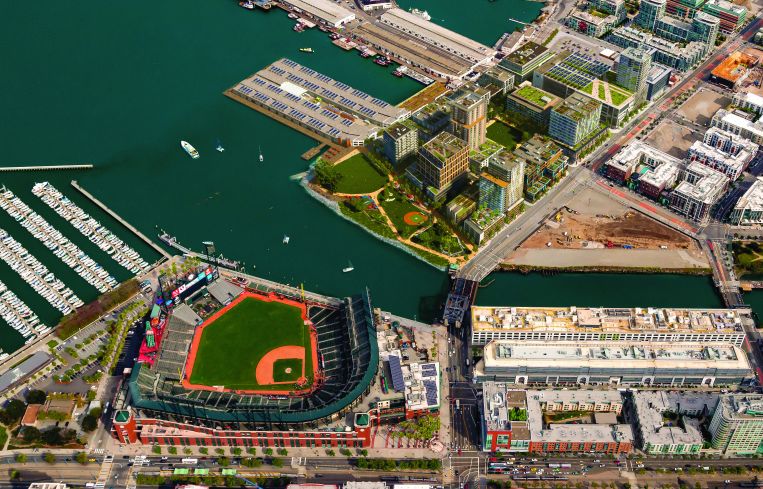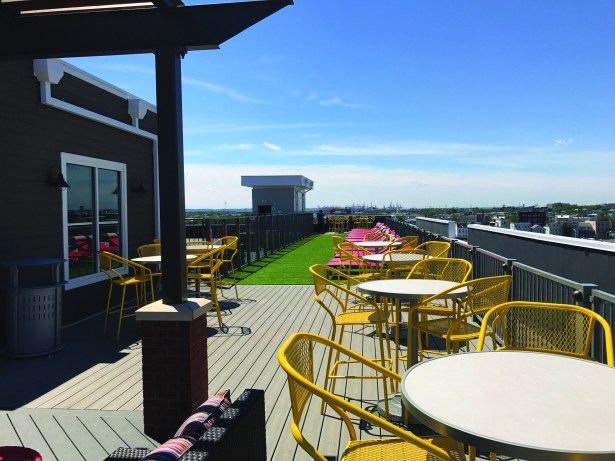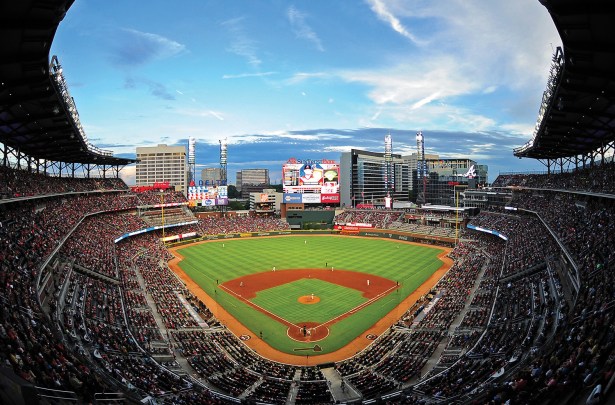Developers Bet Mixed-Use Sports Venues Will Create Double-Play Potential
If you build it, will they come?
By Mack Burke August 14, 2018 9:45 am
reprints
How big a New York Red Bulls fan is Harrison, N.J. resident Ryan Meizinger? He and his brother took an apartment at luxury rental building Steel Works that’s a five-minute walk away from Red Bull Arena.
Of course, he wouldn’t have been able to do so if stadiums weren’t spawning a lot of ancillary real estate around them.
Steel Works—located at 1200 Frank E Rodgers Blvd South—is one of six projects, totaling 20,000 square feet of retail space and 2,000 residential units, that Advance Realty and joint venture partner Tampa Bay, Fla.-based developer DeBartolo Development will develop as part of their planned urban mixed-use Riverbend District project around Red Bull Arena.
“If you look at other major cities with sports teams—no matter the sport—having arenas in the downtown areas has enabled those cities to revitalize the areas around it in a mixed-use capacity with apartments, retail, office, restaurants and bars, you name it,” Dan Cocoziello, the principal and managing director of development at Advance Realty, told Commercial Observer.
The city of Harrison—once upon a time called a “beehive of industry”—is a smaller example of stadium-area development in dense but expansive markets across the country. Other larger examples of current or proposed construction can be found in Tampa, Fla., Milwaukee, Wis., Washington, D.C., Minneapolis, Minn. and Long Island, N.Y. Many cities are seeing the construction of mixed-use components as part of new stadium development and around existing sports venues, as is the case with Red Bull Arena.
Red Bull Arena opened eight years ago, but Advance and DeBartolo have seized on the opportunity to capitalize on this growing national trend. Riverbend District, which also benefits from the close proximity of the Harrison PATH train, will span 132 acres around the stadium and will include a 350-key hotel with 25,000 square feet of conference space, more than 1.7 million square feet of office space and 800,000 square feet of retail space, according to project information from Advance and DeBartolo.
The development efforts are aimed at creating positive neighborhood fundamentals, using the draw of a stadium to sustain a long-term play predicated on providing a hub for entertainment that can be frequented year-round. That’s an inversion of the classic “if you build it, they will come,” strategy of raising a stadium alone and hoping it attracts consistent foot traffic, said Robert Sammons, Cushman & Wakefield’s regional director for Northern California research.
Historically, a lot of stadiums have been built alone in spacious suburban areas or in downtowns without supplemental attractions or sufficient public transit. Being that stadiums sit empty during away games or the off season, it can be hard for expensive venues to realize significant economic benefits for local communities.
Questions concerning how much economic growth a stadium could bring to a city or an area has always been a thorny topic. In a 2015 segment of John Oliver’s popular HBO show Last Week Tonight which garnered over 10 million hits on YouTube alone, the comedian delved into the less-than-positive statistics which show that when cities offer municipal bonds, tax breaks, and other perks to developers in order to draw them to the area, that investment often far outweighs the returns, and the taxpayers end up losing money. As Oliver quipped, “No one has ever said, ‘Hey, let’s go hang out in the area around the stadium and I’ll tell you why—I’ve got a new shirt and I really want someone to vomit Miller Lite and nachos all over it.’ ”
However, in a 2015 report by the Stanford News Service that outlined the negative effects sports venues and public financing can have on local economies, Stanford University professor of economics Roger Noll hinted that one positive trend could be that “future facilities will be embedded in larger commercial and residential projects, with the sports team being like an anchor tenant at a shopping center.”
Since these developments are still met with a certain level of public distrust, teams and developers have been considering ways to make them more attractive and feasible when integrating them into downtowns and suburbs.
“There’s this new wave of development this cycle that’s trending towards a lot of mixed-use centers rather than distinct and separate multifamily housing and then your separate retail center and office space,” Matthew Schreck, a quantitative strategist at online real estate marketplace Ten-X, told CO. “Especially with the troubles that we’re seeing in the retail sector as a whole, there’s been a lot of this trend toward mixed-use, so it makes sense from a developer’s perspective to try to marry this whole thing into a lifestyle pitch basically.”

San Francisco’s more mature and overheated Mission Bay neighborhood and submarket is close to hosting two expansive mixed-use venues: Mission Rock as an extension of AT&T Park, and the planned $1 billion Chase Center. AT&T Park hosts Major League Baseball’s San Francisco Giants and will soon be joined by the 18,000-seat Chase Center, which will debut in 2019 as the new home of the National Basketball Association’s 2018 champion Golden State Warriors.
The privately financed Chase Center is a massive entertainment hub being built by Clark Construction Group and Mortenson Construction that will include two office buildings, restaurants and public plazas as well as a new five-and-a-half-acre public park on the bay waterfront, according to information from Clark Construction. Cushman & Wakefield was tapped to fill 100,000 square feet of retail and restaurant space at the entertainment center.
The success of these developments often depends in part upon the availability of public transit to provide easy access for fans, consumers, tourists and general patrons.
Harrison’s $256 million PATH train redevelopment will bolster future growth at Riverbend, according to Cocoziello, and San Francisco is in the process of expanding its Third Street light rail system into Mission Bay in order to solidify Chase Center’s connection with bordering neighborhoods. The hefty public costs of the expansion have drawn the ire of locals despite the arena itself being privately financed.
Just north of Chase Center and across McCovey Cove beyond the right field wall at AT&T Park, a consortium of commercial real estate firms is working toward a mixed-use project called Mission Rock. Construction is expected to commence in 2019, according to information from the Port of San Francisco’s website. The project will span 28 acres and comprise 1.3 million to 1.7 million square feet of commercial space, 750,000 to 1.5 million square feet of residential space, 150,000 to 200,000 square feet of retail and 850,000 square feet of structured parking.
One perk of the Mission Bay neighborhood is that these projects will already benefit from an extremely busy and crowded market.
“The whole Mission Bay submarket has a zero percent vacancy rate right now as far as office space goes and space for life sciences,” Sammons said, highlighting Uber’s move to occupy roughly half of the 580,000 square feet of office space at Chase Center. “It’s amazingly tight. It’s not a huge submarket right now; it’s about 2 million square feet altogether and DropBox has moved their headquarters down to Mission Bay as well.”
But what about suburban markets?
Several hours south of Mission Bay in Los Angeles’ Inglewood is the future home of a 298-acre mixed-use site that will feature the $2.6 billion LA Stadium and Entertainment District at Hollywood Park (LASED).
The focal point of the project is the 70,000-seat football stadium, currently under construction, which will host home games for the National Football League’s LA Rams and LA Chargers and also the opening and closing ceremonies for the 2028 Olympics. Its seating can be expanded to accommodate up to 100,000 patrons.
LASED will also have a 6,000-seat performing arts venue, 780,000 square feet of office space, 890,000 square feet of retail space, 300 hotel rooms, 2,500 apartments and residences, and around 25 acres for public parks, open space, pedestrian walkways and bicycle paths. It will also include event, conference and meeting spaces.
As of now, the future of public transit to the site is being explored. The town of Inglewood has proposed setting up an automated tram to link to the city’s Crenshaw light rail line that would run along South Prairie Avenue, which directly borders the western side of the district. A June report estimated the cost of constructing the line at around $750 million and then an additional $17 million per year for operational costs.
LASED has spurred plenty of interest in surrounding real estate and is sure to attract masses of patrons as it also sits just a short drive from Los Angeles International Airport and can be seen clearly from the air as flights make their descents.
In Atlanta, the owner of MLB’s Atlanta Braves, Liberty Media Group, shelled out around $400 million to construct the team’s mixed-use venue, The Battery Atlanta, an epicenter of amusement and services directly behind the new 41,000-seat SunTrust Park that officially opened in March 2017. The Battery is complete with a 264-key Omni Hotel that towers over the park’s right field wall and is a beacon for the venue. The Braves also recently announced the addition of Aloft Hotel to The Battery, which is owned by W Hotels and is set to open in 2020.

The Battery is flush with amenities that make it essentially a vibrant micro-neighborhood. Comcast moved its regional headquarters to the area, and there’s a slew of restaurants, shops and attractions lining its streets.
Again, the question-mark is transportation: SunTrust Park is located in Cumberland within Cobb County, 13 miles north from downtown Atlanta and on the outskirts of the city, where public transportation to the venue is limited to bus service. Because it depends on establishing a system of parking and accessibility at these mixed-use venues, it can be hard to gauge how to support the potential flows of traffic.
In the mid-2000s, the Bronx Parking Development Company created by the City of New York erected several parking structures for the New York Yankees as part of a deal with the city to rebuild Yankee Stadium and stay in the Bronx. The company borrowed $237 million from the private bond market to construct and operate the garages, planning to use the proceeds to pay back that debt.
However, the ballclub and the Bloomberg administration overestimated the number of patrons that would drive to the stadium rather than use public transportation, nearly bankrupting the parking company.
There isn’t a wealth of evidence exploring the possible impacts these mixed-use sports venues might have on surrounding commercial real estate and local economies.
Schreck authored a report in 2016 that explored the performance of the retail and multifamily sectors within submarkets that house new stadiums relative to each venue’s respective markets as a whole.
For multifamily, the report sampled 12 fairly new venues for NFL, NBA and MLB teams, including AT&T Park and Brooklyn’s Barclays Center. It found that the five-year stadium submarket absorption and completion rates outperformed the overall market post-opening 75 percent and 83 percent of the time, respectively, while net operating income (NOI) growth outperformed the overall market 50 percent of the time post-opening.
That suggests that there is indeed increased renter demand post-construction and that developers have an increased appetite to meet that demand.
For the retail sector, Schreck sampled nine of the newest NFL and MLB stadiums, including the San Francisco 49ers’ new Santa Clara venue, Levi’s Stadium. The report found that the five-year submarket absorption and completion rates following the first announcement of the venues each outslugged their overall markets just 44 percent of the time, a higher percentage than the performance compared to post-opening. Interestingly, NOI growth post-announcement outperformed the overall market 78 percent of the time versus 67 percent post-opening.
These mixed-use venues have sprouted up or have been proposed in markets across the country. The properties essentially allow developers to create and manage their own real estate fundamentals in many cases. In Edmonton, Canada, the capital of Alberta, the city’s downtown has had a change of scenery with the mixed-use ICE District which revolves around the new stadium venue, Rogers Place, the home of the National Hockey League’s Edmonton Oilers.
In early July, MLB’s Tampa Bay Rays proposed bringing a $900 million mixed-use stadium with a translucent roof to the city’s Ybor City area, a plan that would have the team vacate its original home at Tropicana Field in nearby St. Petersburg, Fla. It was reported that the team would offer developers square footage at the site in return for helping fund the development.

In Washington, D.C., the vaunted Major League Soccer team D.C. United just moved from its original home at RFK Stadium and into a new $300 million, 20,000-seat Audi Field in July, which consists of 500,000 total square feet of mixed-use retail and residential space on site. Like Mission Bay, it’s joined by another venue, Nationals Park, home of MLB’s Washington Nationals, which is just a few blocks away in an area the District has been trying to revitalize into a sports and entertain hub. Both venues were heavily financed through public subsidies and have faced staunch criticism over whether they’ll meet the economic effects expected by local officials.
Cocoziello said The Battery Atlanta is a project that mirrors what Advance and DeBartolo are looking to accomplish in Harrison, although The Battery is predicated more on office, hospitality and retail assets. Currently, the joint venture is focused on its multifamily projects, expecting these projects to spark demand for additional amenities.
“Over the last three years, you’ve seen the area really start to change, especially on game days and during events,” Cocoziello said. “It’s only going to get better when the PATH train opens up, when retail follows behind some of the density and the daytime population [continues to grow]. We couldn’t be more excited about the direction of Riverbend.”
Harrison, N.J. is certainly a smaller case that speaks to the larger trend of developers focusing heavily on building out strong transit-oriented mixed-use projects as extensions of sports venues.
“Aside from the fact that it’s a great development area economically, it’s got great transit options, with the PATH station there and connectivity to New York City,” said Schreck. “There are so many factors that go into where people are choosing to live and that sort of drives retail traffic and retail performance. It’s a multifaceted exercise.”
As for Harrison-based Meizinger, he said he began regularly attending Red Bull games around five years ago and has seen a material difference in the vibrancy of the area as development began rising around Red Bull Arena.
“The area has already improved drastically; there used to just be a Dunkin’ Donuts down the street,” Meizinger said. “For me, it’s like working at a small company where you get to grow with that company. With Harrison, it sort of feels like you’re growing with the neighborhood; there’s a ton of real estate, and they’re making improvements to the PATH. I think it’s really exciting.”



